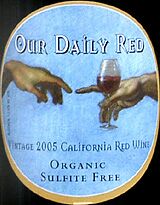|
This article was published in The 30 Second Wine Advisor on Monday, June 26, 2006.
No sulfites added
Every summer during vacation season, when North American wine enthusiasts head to Europe to see the sights and enjoy good food and wine, I get a flurry of E-mail questions like this:
Well, no, actually it's not. Sulfites are a natural, organic preservative that humans have been using in wine and other foods for several thousand years. The only difference between France and the U.S. is that the U.S. requires a warning label, and warning labels create the unfortunate impression that where there's a warning, there must be something dangerous afoot.
And in fact there is, but that danger threatens only a relative handful of individuals - sulfite-sensitive asthmatics - for whom any exposure to sulfites could trigger potentially fatal respiratory problems. But sulfite-sensitive adults already know what they must avoid - a list that includes wine, fruit juice, sausages, salad bars and many other foodstuffs that routinely use sulfiting in production.
As I wrote when we last featured this topic on Sept. 1, 2003, the U.S. Food and Drug Administration (FDA) includes sulfites on its "generally recognized as safe" (GRAS) list of food additives. But U.S. regulators have also required since 1987 that all foodstuffs containing more than 10 parts per million (ppm) of sulfites must bear a warning label. Curiously, moreover, regulators set a maximum limit of 350 ppm for sulfites in alcoholic beverages, while allowing some processed foods up to 6,000 ppm.
If you get a headache or a stuffy nose after drinking wine, you may be allergic to something - very likely the histamines in some red wines, or in the case of hangovers, simple over-indulgence. But it's not the sulfites.
So why do so many travelers (me, too!) report being able to enjoy a little harmless over-indulgence on vacation without the recriminations that would surely ensue at home? My guess, frankly, is that it's mostly psychological. We're traveling, we're relaxed, we're having a great time, and we shrug off minor irritations that would seem more bothersome on a working day. Whatever the explanation of this happy consequence, I can say one thing with certainty: It doesn't have anything to do with sulfites in the wine. To repeat: The only difference between the wines we drink in France (or Italy, or anywhere else in Europe) and the wines we enjoy at home is the warning label.
By coincidence, over the weekend I also picked up a modestly priced California wine that's labeled "organic sulfite free," terminology that requires a little explanation. Under relatively recent federal regulations governing organic labeling, a wine made with organic vineyard practices but using sulfites as a natural preservative must be labeled "Made with organically grown grapes." To qualify for the label "organic sulfite free," it must have no sulfites added during production; however, it may contain up to 10 parts per million naturally occurring sulfites, a small dose that occurs as a byproduct of fermentation. In short, "sulfite-free" isn't, really, although the sulfites are at such a low level that even sensitive individuals shouldn't be able to detect them.
A blend of Fresno Syrah and Carignan and Mendocino Cabernet Sauvignon labeled as "Certified organic by guaranteed organic certification agency," "USDA Organic" and "Organic Sulfite Free," this is a very dark ruby wine, showing a distinct haze when it's held up to the light. Simple red-fruit aromas focuse on plums and berries. Tart and "grapey," red plums and wine grapes and a tart, zippy snap of citrus that borders on sour. A distinctly prickly tickle of just-perceptible carbonation suggests that it may be prone to a secondary fermentation in the bottle, which would not be a good thing. I'd rate it as drinkable but not well-balanced, with some indication that it may be less than fully stable on the shelf. (June 24, 2006)
FOOD MATCH: Simple, fruity and acidic, it serves well with red meats from burgers to my choice, pan-seared rib eye steak; it should also make a decent vegetarian match with Cheddar or other relatively mild cheese.
VALUE: It's idiosyncratic, but not a bad value under $10, provided you're willing to take the risk that it has held up in the bottle.
WHEN TO DRINK: I suggest treating a wine made without preservatives as you would fresh fruit: Enjoy it while it's fresh, but don't expect it to last.
WEB LINK:
FIND THIS WINE ONLINE:
|
 Nevada County Wine Guild 2005 "Our Daily Red" California Red Wine ($9)
Nevada County Wine Guild 2005 "Our Daily Red" California Red Wine ($9)